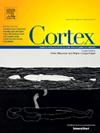青少年肌阵挛性癫痫的网络神经心理学
IF 3.2
2区 心理学
Q1 BEHAVIORAL SCIENCES
引用次数: 0
摘要
在青少年肌阵挛性癫痫(JME)的临床神经心理学中,未知的是该疾病对特定认知能力之间关系的本质的影响,包括它们的整合、分离和地形组织模式——也就是说,JME的网络神经心理学仍有待解决。本文研究了JME中认知网络的状态,以及这种遗传性全身性癫痫患者的未受影响的兄弟姐妹中是否存在类似的网络改变。参与者包括78名JME患者(平均年龄= 19.8±3.7岁),19名未受影响的兄弟姐妹(平均年龄= 15.9±3.3岁)和43名不相关的对照组(平均年龄= 20.2±3.2岁),所有人都接受了全面的临床神经心理学测试,其中15个指标作为图论分析的节点。通过计算中间性中心性,计算出全局度量指数(即归一化全局效率、归一化平均聚类系数、模块化)和地标性“枢纽”。显著的JME网络发现包括:1)测试措施的相互关系显著增强(即增加的正流形);2)隔离显著降低(即归一化平均聚类系数),但网络效率相似(即归一化整体效率);3)网络中认知模块的划分强度显著降低(即模块化指数)。关于已识别的认知网络的地形结构(即其社区结构),未受影响的兄弟姐妹和不相关的对照组表现出三个认知模块(速度/执行功能,知觉,语言),而JME则表现出两个模块-其中一个是未分化的“g-like”,以及速度/执行功能。总体而言,JME与认知子系统(即模块)的分离程度较低有关,这表明认知过程的专业化程度较低,心理测量测量的相互关系异常,以及由此产生的认知网络的总体配置(数量较少,内容和结构非典型),这似乎是导致他们的认知状况普遍较差的原因。未受影响的兄弟姐妹显示出这些非典型网络特征的一些外显性。本文章由计算机程序翻译,如有差异,请以英文原文为准。
The network neuropsychology of juvenile myoclonic epilepsy
Unknown in the clinical neuropsychology of Juvenile Myoclonic Epilepsy (JME) is the impact of the disorder on the nature of the relationships of specific cognitive abilities among themselves including their patterns of integration, segregation, and topographical organization—that is, the network neuropsychology of JME remains to be addressed. Examined here is the status of cognitive networks in JME and whether similar network alterations are present in the unaffected siblings of patients with this genetic generalized epilepsy. Participants included 78 with JME (mean age = 19.8 3.7 yrs), 19 unaffected siblings (mean age = 15.9 3.3 yrs) and 43 unrelated controls (mean age = 20.2 3.2 yrs), all administered a comprehensive clinical neuropsychological battery from which 15 metrics served as nodes for graph theory analyses. Calculated were global metric indices (i.e., normalized global efficiency, normalized average clustering coefficient, modularity) and landmark “hubs” by calculating betweenness centrality. Salient JME network findings included: 1) significantly greater intercorrelation of test measures (i.e., increased positive manifold), 2) significantly lower segregation (i.e., normalized average clustering coefficient) but similar network efficiency (i.e., normalized global efficiency), and 3) significantly lower strength of the division of the cognitive modules in the network (i.e., modularity index). Regarding the topographical structure of identified cognitive networks (i.e., their community structure), unaffected siblings and unrelated controls demonstrated three cognitive modules (speed/executive function, perceptual, language) while JME demonstrated two modules—one of which was undifferentiated and “g-like”, and speed/executive function. Overall, JME is associated with less segregation of cognitive subsystems (i.e., modules) indicating less specialization in cognitive processes, abnormalities in the interrelationships of psychometric measures as well as the general configuration of their resulting cognitive networks (fewer in number and atypical in content and structure) which appear to be contributing to their generally poorer cognitive status compared to controls. Unaffected siblings show some penetrance of these atypical network features.
求助全文
通过发布文献求助,成功后即可免费获取论文全文。
去求助
来源期刊

Cortex
医学-行为科学
CiteScore
7.00
自引率
5.60%
发文量
250
审稿时长
74 days
期刊介绍:
CORTEX is an international journal devoted to the study of cognition and of the relationship between the nervous system and mental processes, particularly as these are reflected in the behaviour of patients with acquired brain lesions, normal volunteers, children with typical and atypical development, and in the activation of brain regions and systems as recorded by functional neuroimaging techniques. It was founded in 1964 by Ennio De Renzi.
 求助内容:
求助内容: 应助结果提醒方式:
应助结果提醒方式:


